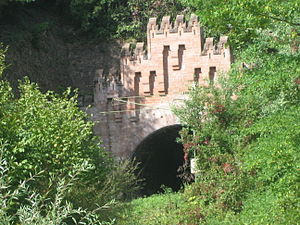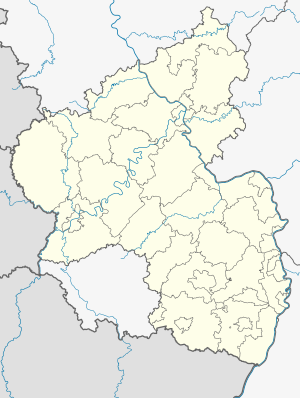Iron wedge tunnel
| Iron wedge tunnel | ||
|---|---|---|
|
The south portal of the Eisenkehl tunnel is under monument protection
|
||
| use | Railway tunnel | |
| traffic connection | Mannheim – Saarbrücken railway , Palatinate Ludwig Railway | |
| place | Frankenstein (Palatinate) , Weidenthal | |
| length | 65 m | |
| Number of tubes | 1 | |
| construction | ||
| Client | Palatine Ludwig Railway Company | |
| start of building | 1845 | |
| business | ||
| operator | Deutsche Bahn | |
| release | August 25, 1849 | |
| location | ||
|
|
||
| Coordinates | ||
| North portal | 49 ° 25 ′ 40 " N , 7 ° 58 ′ 49" E | |
| South portal | 49 ° 25 ′ 38 " N , 7 ° 58 ′ 50" E | |
The iron wedge tunnel is one of a total of twelve tunnels on the Mannheim – Saarbrücken railway line that emerged from the Palatinate Ludwigsbahn and, at 65 meters, is the shortest. Originally laid out as a single track, the line was expanded to double tracks a few years later. The tunnel's striking south portal is a listed building.
location
The tunnel is located at kilometer 61.1 and crosses the boundary of the local communities Frankenstein (north portal) and Weidenthal (south portal), which also forms the border between the districts of Kaiserslautern and Bad Dürkheim . Not far from it, a few hundred meters further south-east, the Köpfle tunnel joins. At the north portal there is a railway bridge that spans the federal highway 39 , which runs parallel to the route . To the east of the latter is the hamlet of Eisenkehl, which belongs to Weidenthal . Not far from the south portal, the Hochspeyerbach passes under the railway tracks, the loop of which the tunnel shortens.
history
On December 21, 1837, the Bavarian King Ludwig I gave the green light to the construction of a main line in an east-west direction from the Rheinschanze to Bexbach . Between Neustadt and Frankenstein numerous hills and foothills had to be overcome for the ascent. Among them there were some within Weidenthal. This required the construction of a 65 meter short tunnel in this area; Paul Camille von Denis was responsible for its construction as for the entire Ludwigsbahn . Traffic from Ludwigshafen to Neustadt had already been opened in 1847, and in 1848 the Homburg – Frankenstein section followed in two stages. On August 25, 1849, the gap between Frankenstein and Neustadt including the iron wedge tunnel followed. Carriages had previously taken over the traffic between the two sections of the route. In July 1856, the Ludwig Railway was then consistently double-tracked.
At the beginning of the 20th century, the tunnel was administered by the Neustadt a Hardt Operations and Construction Inspectorate and belonged to the Lambrecht Railway Maintenance Department . In 1922 the tunnel was incorporated into the newly founded Reichsbahndirektion Ludwigshafen . With the dissolution of the Ludwigshafen management on April 1, 1937, the station changed to the responsibility of the Mainz management and the Neustadt operations office (RBA). The German Federal Railways was divided the station after the Second World War in the Bundesbahndirektion Mainz, who all railway lines within the newly created state of Rhineland-Palatinate allotted.
Since the main line from Mannheim to Saarbrücken has always been of great importance for long-distance traffic, it was gradually electrified from 1960. The iron wedge tunnel had to be widened for electrification, which delayed the completion of electrical operation, but could be started on March 12, 1964 on the entire route. In the course of the gradual dissolution of the Mainz directorate, from August 1, 1971 until the rail reform, the one in Karlsruhe was responsible for the station.
Building
The south portal contains several stepped gables . Denis intended to adapt it from an architectural point of view to the geographic conditions in the form of castles and mountains. The north portal is rather simple. There are also inscriptions on both portals.
literature
- Fritz Engbarth: From the Ludwig Railway to the Integral Timed Timetable - 160 Years of the Railway in the Palatinate . 2008 ( online [PDF; 4.1 MB ; accessed on October 9, 2013]).
- Heinz Sturm: The Palatinate Railways (= publications of the Palatinate Society for the Advancement of Science. Volume 53). New edition. pro MESSAGE, Ludwigshafen am Rhein 2005, ISBN 3-934845-26-6 .
Web links
Individual evidence
- ↑ a b General Directorate for Cultural Heritage Rhineland-Palatinate (ed.): Informational directory of cultural monuments - Bad Dürkheim district. Mainz 2020, p. 99 (PDF; 5.1 MB).
- ↑ eisenbahn-tunnelportale.de: Pictures of the route: 3280 (KBS 665.1, 665.2, 670 / KBS 279) . Retrieved September 27, 2015 .
- ↑ Heinz Sturm: The Palatinate Railways . 2005, p. 53 .
- ^ Klaus Detlef Holzborn: Railway Reviere Pfalz . 1993, p. 85 .
- ↑ Heinz Sturm: The Palatinate Railways . 2005, p. 96 .
- ↑ Heinz Sturm: The Palatinate Railways . 2005, p. 113 ff .
- ↑ Heinz Sturm: The Palatinate Railways . 2005, p. 146 .
- ↑ Heinz Sturm: The Palatinate Railways . 2005, p. 267 .
- ↑ bahnstatistik.de: Royal Bavarian Railway Directorate Ludwigshafen a. Rhine - Timeline: Establishments - Designations - Dissolutions . Retrieved June 4, 2015 .
- ↑ Fritz Engbarth: From the Ludwig Railway to the Integral Timed Timetable - 160 Years of the Railway in the Palatinate . 2007, p. 23 f .
- ↑ bahnstatistik.de: railway management Mainz - Timeline: erections - names - resolutions . Retrieved June 4, 2015 .
- ↑ Werner Schreiner: Paul Camille von Denis. European transport pioneer and builder of the Palatinate railways . 2010, p. 83 .
- ↑ eisenbahn-tunnelportale.de: Line 3280: iron wedge tunnel . Retrieved September 27, 2015 .

